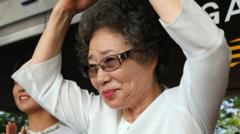**As students increasingly occupy cafes for long hours, businesses are implementing new guidelines and policies to restore balance.**
**Cafes in South Korea Face Pressure from 'Cagongjok' Students**

**Cafes in South Korea Face Pressure from 'Cagongjok' Students**
**Coffee shops are struggling to balance student demand and community space needs amid the 'Cagongjok' phenomenon.**
In the bustling neighborhood of Daechi, Seoul, Hyun Sung-joo, a cafe owner, finds himself caught in a challenge as his establishment becomes a favorite among students who engage in prolonged study sessions known locally as "Cagongjok." Recently, he encountered a customer who occupied a table with dual laptops and a six-outlet power strip, prompting him to restrict access to the cafe's power sources due to the high costs of maintaining his business.
This phenomenon of Cagongjok has surged in popularity among South Korean youth, significantly more than in Western countries, leading to an environment where cafes are dominated by individuals using the spaces for studying. Starbucks Korea, noticing the trend, recently announced guidelines to mitigate extreme cases where patrons not only monopolize tables for hours but also bring in bulky equipment, thus disrupting the cafe's atmosphere.
While these policies aim to create a more balanced environment for all customers, many moderate users of cafe study spaces feel the impact of space regulations. Deep inside a busy Starbucks in Gangnam, students, like an 18-year-old preparing for the competitive university entrance exam, often start their day early and work late into the evening, sometimes leaving their belongings unattended.
The reaction to Starbucks' new policies is varied; many welcome a return to a more social environment in cafes, citing that excessive presence of Cagongjok has made it difficult to find seats, causing a hushed ambiance. However, some critics view the changes as overly restrictive, arguing that it shifts away from Starbucks' previously relaxed approach.
The rapid growth of coffee shops in South Korea—approximately 48% in the last five years—has fueled this ongoing discussion. According to surveys, around 70% of Gen Z job seekers admit to studying in cafes at least once a week, highlighting caffeine-fueled education as a norm.
Independent cafe owners also report challenges posed by customers who take over communal spaces for long stretches. Many business owners find themselves setting limits in a bid to ensure that their cafes remain welcoming to those seeking leisurely interactions instead of intensive study. For example, Kim, a cafe owner from Jeonju, imposed a "No Study Zone" rule, while others, like Hyun, are more lenient and appreciate considerate patrons ordering additional drinks during their lengthy stays.
The motivations for preferring cafes over libraries or home environments can be deeply personal. For individuals like Yu-jin Mo, who has experienced challenging living conditions, cafes provide a sense of belonging where they feel more at ease. The deeper societal implications of this trend were also echoed by Professor Choi Ra-young of Ansan University, who attributes the rise of Cagongjok to a competitive culture that pressures youth to seek solace and space in coffee shops, especially considering the limited public study areas.
As South Korea grapples with the implications of Cagongjok, experts urge an exploration of more inclusive and accommodating spaces that meet the needs of this community, balancing the interests of businesses and patrons alike.
This phenomenon of Cagongjok has surged in popularity among South Korean youth, significantly more than in Western countries, leading to an environment where cafes are dominated by individuals using the spaces for studying. Starbucks Korea, noticing the trend, recently announced guidelines to mitigate extreme cases where patrons not only monopolize tables for hours but also bring in bulky equipment, thus disrupting the cafe's atmosphere.
While these policies aim to create a more balanced environment for all customers, many moderate users of cafe study spaces feel the impact of space regulations. Deep inside a busy Starbucks in Gangnam, students, like an 18-year-old preparing for the competitive university entrance exam, often start their day early and work late into the evening, sometimes leaving their belongings unattended.
The reaction to Starbucks' new policies is varied; many welcome a return to a more social environment in cafes, citing that excessive presence of Cagongjok has made it difficult to find seats, causing a hushed ambiance. However, some critics view the changes as overly restrictive, arguing that it shifts away from Starbucks' previously relaxed approach.
The rapid growth of coffee shops in South Korea—approximately 48% in the last five years—has fueled this ongoing discussion. According to surveys, around 70% of Gen Z job seekers admit to studying in cafes at least once a week, highlighting caffeine-fueled education as a norm.
Independent cafe owners also report challenges posed by customers who take over communal spaces for long stretches. Many business owners find themselves setting limits in a bid to ensure that their cafes remain welcoming to those seeking leisurely interactions instead of intensive study. For example, Kim, a cafe owner from Jeonju, imposed a "No Study Zone" rule, while others, like Hyun, are more lenient and appreciate considerate patrons ordering additional drinks during their lengthy stays.
The motivations for preferring cafes over libraries or home environments can be deeply personal. For individuals like Yu-jin Mo, who has experienced challenging living conditions, cafes provide a sense of belonging where they feel more at ease. The deeper societal implications of this trend were also echoed by Professor Choi Ra-young of Ansan University, who attributes the rise of Cagongjok to a competitive culture that pressures youth to seek solace and space in coffee shops, especially considering the limited public study areas.
As South Korea grapples with the implications of Cagongjok, experts urge an exploration of more inclusive and accommodating spaces that meet the needs of this community, balancing the interests of businesses and patrons alike.


















